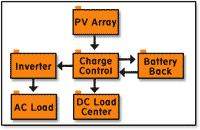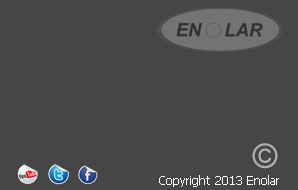Solar Indoor Lighting Systems

Power cuts are becoming a common feature now days in many cities, metros, villages and remote areas. In addition, the electricity tariffs are increasing every year. Enolar has evolved Solar Indoor Lighting Systems to overcome the problems of uncertainty in electricity supply. The Solar Indoor Lighting System is highly reliable, excellent quality power supply. It is free of grid failures and other factors. By installing the solar Indoor lighting system, one can get rid of the hassles of frequent electrical failures and poor quality of supply from the main grid. This system can power any desired combination of lights based on the total system capacity.
A Typical Indoor Lighting system consists of the following :
- Solar Modules
- Low maintenance, lead-acid, tubular or maintenance-free battery
- High Efficiency Electronics comprising of AC charger, Charge Controller, & Inverter (High Frequency & Low Frequency).
- Structure for Solar Panels & Batteries
- Installation, Instruction & Maintenance Manual.
Salient Features :
- Solar Indoor Lighting system is a solution for the uncertainty in the availability of quality electricity.
- This system can power any desired combination of loads like lighting, fan, computer, colour television & Appliances like Mixers, Washing machines etc.
- Highly reliable power supply
- Independent supply, which can yet be integrated with the Grid
- Savings in electricity bills
- Totally user controlled, Wide range of models are available.
We can assist you in selection of the right configuration, depending on the load that is to be used.
Different Configurations of Solar Indoor Lighting Systems :
A Stand-alone DC system is use full where lighting requirements are very less. The Stand-alone system is an excellent replacement for propane or kerosene lights in a remote cabin, a recreational vehicle or a boat. These systems are basically designed to cater to the requirements of Rural Lighting.
A Typical Stand Alone Lighting system consists of the following :
- Solar Module
- Low maintenance, lead-acid, tubular or maintenance-free battery
- DC Lighting Fixtures with very high efficiency High frequency inverters & optional DC Fans
- Structure for Solar Panels & Batteries
- Wires & Accessories
- Installation, Instruction & Maintenance Manual
Salient Features :
- Solar Stand Alone DC Lighting system is a solution for the uncertainty in the availability of quality electricity, particularly rural lighting
- This system can be designed to power a maximum of 10 DC Lights & a few DC fans
- Separate wiring has to be done, as the loads are all DC loads
- Highly reliable power supply and independent of Electricity Board
- Good Savings in electricity bills
- Totally user controlled & specified, Wide range of models are available
- All loads are only DC loads
- Sun is the only source of generating power

The size of the photovoltaic (PV) array and battery will depend upon individual requirements. The PV array charges the battery during daylight hours and the battery supplies power to the loads as needed. The charge regulator terminates the charging when the battery reaches full charge. The load center may contain meters to monitor system operation and fuses to protect wiring in the event of a malfunction or short circuit in the house.
This system is the same as the Stand Alone DC system, except that it contains a DC to AC inverter, an electronic device which converts direct current into alternating current. With the addition of an inverter, commonly available household appliances such as power tools, vacuum cleaners, washing machines and kitchen appliances can be used. High quality DC to AC inverters is available with power outputs ranging from 100 watts to 11 kilowatts, and conversion efficiencies greater than 90%. To insure reliable system operation, the inverter should be carefully matched to the loads that will be run. As the loads on the system are increased, a larger PV array and more battery storage will be required
A Typical Stand Alone AC/DC Lighting system consists of the following :
- Solar Module
- Low maintenance, lead-acid, tubular or maintenance-free battery
- DC Lighting Fixtures with very high efficiency High frequency inverters & optional DC Fans
- DC to AC Inverter for powering AC loads
- Structure for Solar Panels & Batteries
- Wires & Accessories
- Installation, Instruction & Maintenance Manual
Salient Features
- Solar Stand Alone AC/DC Lighting system is a solution for Houses where emergency power is required for using conventional AC loads
- This system can be designed to power any number of AC loads for any number of Back up hours
- Separate wiring may be required sometimes but existing wiring can be used
- Highly reliable power supply and independent of Electricity Board
- Good Savings in electricity bills
- Totally user controlled & specified, Wide range of models are available
- DC Loads include DC lighting fixtures and DC Fans. AC loads include Lights, Fans, Computers and other household electrical appliances
- Sun is the only source of generating power

The size of the photovoltaic (PV) array and battery will depend upon individual requirements. The PV array charges the battery during daylight hours and the battery supplies power to the DC loads directly as needed. AC loads are powered through an inverter. The charge regulator terminates the charging when the battery reaches full charge. The load center may contain meters to monitor system operation and fuses to protect wiring in the event of a malfunction or short circuit.
A stand-alone AC system is one in which all the loads are AC loads only. It will usually have a PV array of ten or more modules, battery bank and one or more inverters. Two or more stackable inverters are an excellent choice for this type of system since they can work together to supply power to large loads. If one fails, the others can continue to operate at reduced output until repairs are made. This redundancy is important for continuously operating critical loads.
In large homes, an AC only system simplifies wiring by allowing the use of low cost, readily available switches, outlets, and fixtures. Savings in wire cost are significant, because the large gauge wire required for efficient transmission of low voltage DC power over long runs is avoided.
A Typical Stand Alone AC Lighting system consists of the following
- Solar Modules Connected in Series & Parallel Combination
- Low maintenance, lead-acid, tubular or maintenance-free battery
- DC to AC Inverter for powering AC loads
- Structure for Solar Panels & Batteries
- Wires & Accessories
- Installation, Instruction & Maintenance Manual
Salient Features

- Solar Stand Alone AC Lighting system is a solution for Big Houses, Bungalows, Institutions, Hotels, and Resorts & Industries. This system can be designed to power any number of AC loads for any number of Back up hours
- Separate wiring is not required, existing wire line can be used
- Highly reliable power supply and independent of Electricity Board
- Good Savings in electricity bills
- Totally user controlled & specified, Wide range of models are available
- AC loads include Lights, Fans, Computers and other household electrical appliances
- Sun is the only source of generating power
The SPV-Hybrid combination system may be an economical alternative to a large stand-alone PV system, because the PV array does not have to be sized large enough for worst-case weather conditions. A gasoline, propane or diesel generator combined with a battery charger can supply power when the PV array falls short.
If the PV array is sized for average conditions, then during extended overcast situations or periods of increased load, the generator can be started. When batteries are low, the generator will power the AC loads in the house as well as a battery charger to help recharge the batteries. If the PV array is sized much smaller than needed for normal use, the generator can power peak loads while simultaneously run the battery charger to charge to battery bank.
A Typical Stand Alone SPV-Hybrid system consists of the following
- Solar Modules Connected in Series & Parallel Combination
- Low maintenance, lead-acid, tubular or maintenance-free battery
- DC to AC Inverter for powering AC loads
- An alternate generator run by Gasoline , Propane or Diesel
- Structure for Solar Panels & Batteries
- Wires & Accessories
- Installation, Instruction & Maintenance Manual
Salient Features

- Solar Stand Alone SPV-Hybrid system is a solution for where power required is in very large quantities. This system can be designed to power any number of AC loads for any number of Back up hours
- Separate wiring is not required, existing wire line can be used
- Highly reliable power supply and independent of Electricity Board
- Good Savings in electricity bills
- Totally user controlled & specified, Wide range of models are available
- AC loads include Lights, Fans, Computers and other household electrical appliances
- Sun is the primary source of generating power but it also has a alternate source of producing energy in the form of Generator

The Utility Interface system is used in a grid-connected house. Electricity generated by the solar system is stored in a battery bank, which provides all or some of the home's power. If the batteries become low, an automatic transfer switch reconnects the house loads to the utility power and the utility power simultaneously charges the battery.
Any size PV array can be used in this type of system, since utility power is available whenever PV produced power is not. Array size can be increased incrementally, requiring less use of utility power.
This type of system can have a lower initial cost. It will function during power outages and can be enlarged over a period of time in a phased manner to make the home independent of the utility.
The net metering system is also used in a grid-connected house, but instead of storing power in batteries, it is sold to the utility company.
The net metering system employs a special type of inverter, which inverts DC power from the PV array into low distortion full sine wave AC power, acceptable for purchase by the local utility power company. Batteries are not required for storage. The power is delivered through a kilowatt-hour (kWh) meter to the utility grid as the PV modules produce it. A second kWh meter is sometimes used to measure the power consumed.
The user of this system will notice no difference from any utility run system, except lower utility bills or possibly payments from the power company for the excess electricity that is generated.
Until recently, the net metering system requires a PV array of 1000 watts or more (12 or more PV modules) to be cost effective since the smallest inverters were 1000 watts (1 kW). Recently, a new, smaller utility inverter has become available, allowing systems as small as 100 watts to feed power back into the grid. Any electricity fed into the grid must be compatible with the power generated by the utility or problems might arise.
Net metering system requires utility power to operate, so a house of this type will have no electricity during a power outage. Adding a battery bank to the PV system would provide power during outages.

